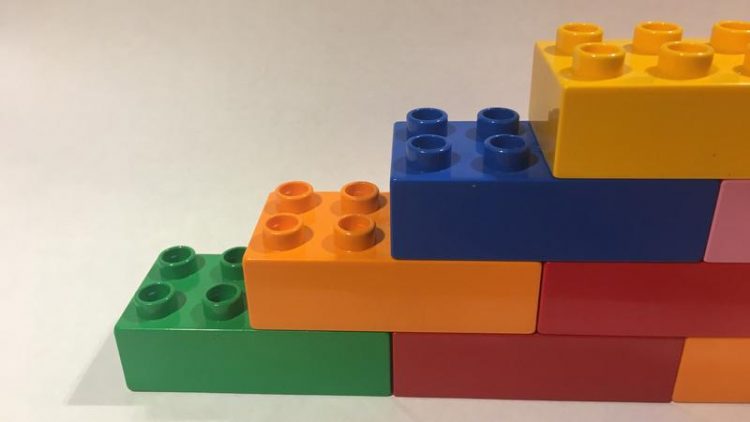Unexpected behaviour of the material: From 2D crystal to 1D wire

Careful polishing produces even steps with a height of exactly one atom – as in the attempt to build a slanted plane using only Lego bricks of the same size. UDE
“Low-dimensional systems are en vogue”, according to Professor Michael Horn-von Hoegen, experimental physicist in the UDE Collaborative Research Centre 1242 “Non-equilibrium dynamics of condensed matter in the time domain”.
For restricting a system of three dimensions to just one creates the possibility of discovering new properties in the material.
Therefore, the scientists used stepped surfaces to allow atomic wires to form in a self-organized way by cutting a silicon crystal at an angle of 12 degrees. Careful polishing produces even steps with a height of exactly one atom – as in the attempt to build a slanted plane using only Lego bricks of the same size.
The edges of the steps are formed by silicon atoms, with two rows of gold atoms deposited behind them.
Atoms shift
The researchers are now interested in every third silicon atom in this row at the edge, because it has special properties: At very low temperatures, these atoms are arranged in a regular lattice (viewed across the steps), i.e., in a two-dimensional crystal structure.
And now heat is added, a term that is quite elastic in physics: from previously -223°C, the system is now heated to around -123°C. This thermal energy causes the regular distances between the special silicon atoms to break up. They are now sometimes two, sometimes four atoms apart.
This way, independent chains of atoms are formed, which run along the edges of the steps. The fact that physicists can explain this phenomenon in detail today is due in large part to the theorist Prof. Björn Sothmann: His calculations explained what the pure experiment could not reveal.
“Here, something new emerges almost out of nowhere,” Horn-von Hoegen summarises. And the result also contradicts previous expectations: “2D order at low temperatures, one-dimensional structures when it gets warmer; you don't get this kind of thing from any other material. Now we want to find out whether this also applies to other systems – maybe even at room temperature”.
The highly respected scientific journal Physical Review Letters covers this in its current issue.
Editor: Birte Vierjahn, +49 203 37 9-8176, birte.vierjahn@uni-due.de
Prof. Dr. Michael Horn-von Hoegen, Fakultät für Physik, +49 203 37 9-1438, horn-von-hoegen@uni-due.de
B. Hafke, C. Brand, T. Witte, B. Sothmann, M. Horn-von Hoegen, S. C. Erwin:
“Thermally Induced Crossover from 2D to 1D Behavior in an Array of Atomic Wires: Silicon Dangling-Bond Solitons in Si(553)-Au”
Phys. Rev. Lett. 124, 016102 (2020)
https://doi.org/10.1103/PhysRevLett.124.016102
Media Contact
More Information:
http://www.uni-duisburg-essen.de/All latest news from the category: Materials Sciences
Materials management deals with the research, development, manufacturing and processing of raw and industrial materials. Key aspects here are biological and medical issues, which play an increasingly important role in this field.
innovations-report offers in-depth articles related to the development and application of materials and the structure and properties of new materials.
Newest articles

High-energy-density aqueous battery based on halogen multi-electron transfer
Traditional non-aqueous lithium-ion batteries have a high energy density, but their safety is compromised due to the flammable organic electrolytes they utilize. Aqueous batteries use water as the solvent for…

First-ever combined heart pump and pig kidney transplant
…gives new hope to patient with terminal illness. Surgeons at NYU Langone Health performed the first-ever combined mechanical heart pump and gene-edited pig kidney transplant surgery in a 54-year-old woman…

Biophysics: Testing how well biomarkers work
LMU researchers have developed a method to determine how reliably target proteins can be labeled using super-resolution fluorescence microscopy. Modern microscopy techniques make it possible to examine the inner workings…





















